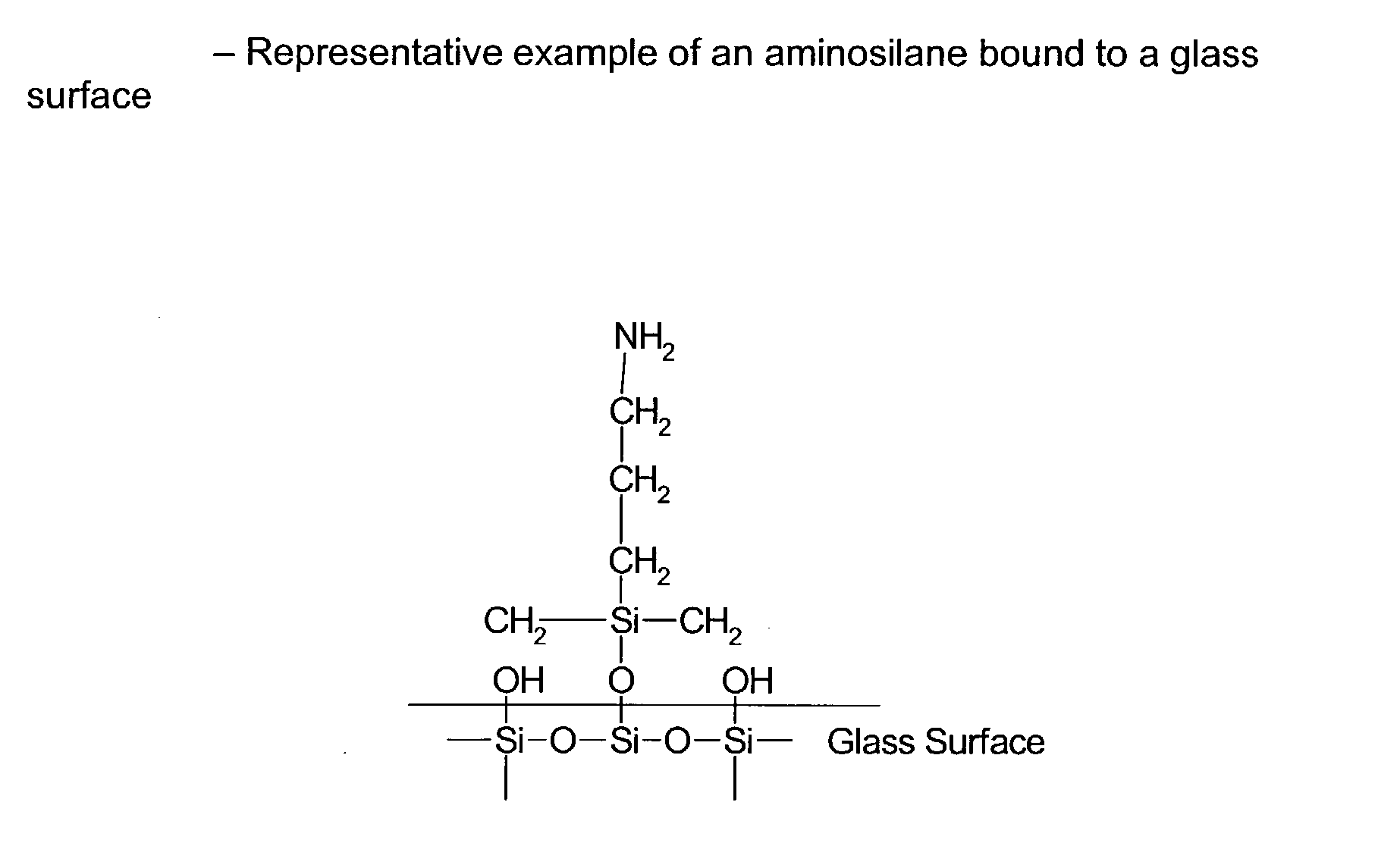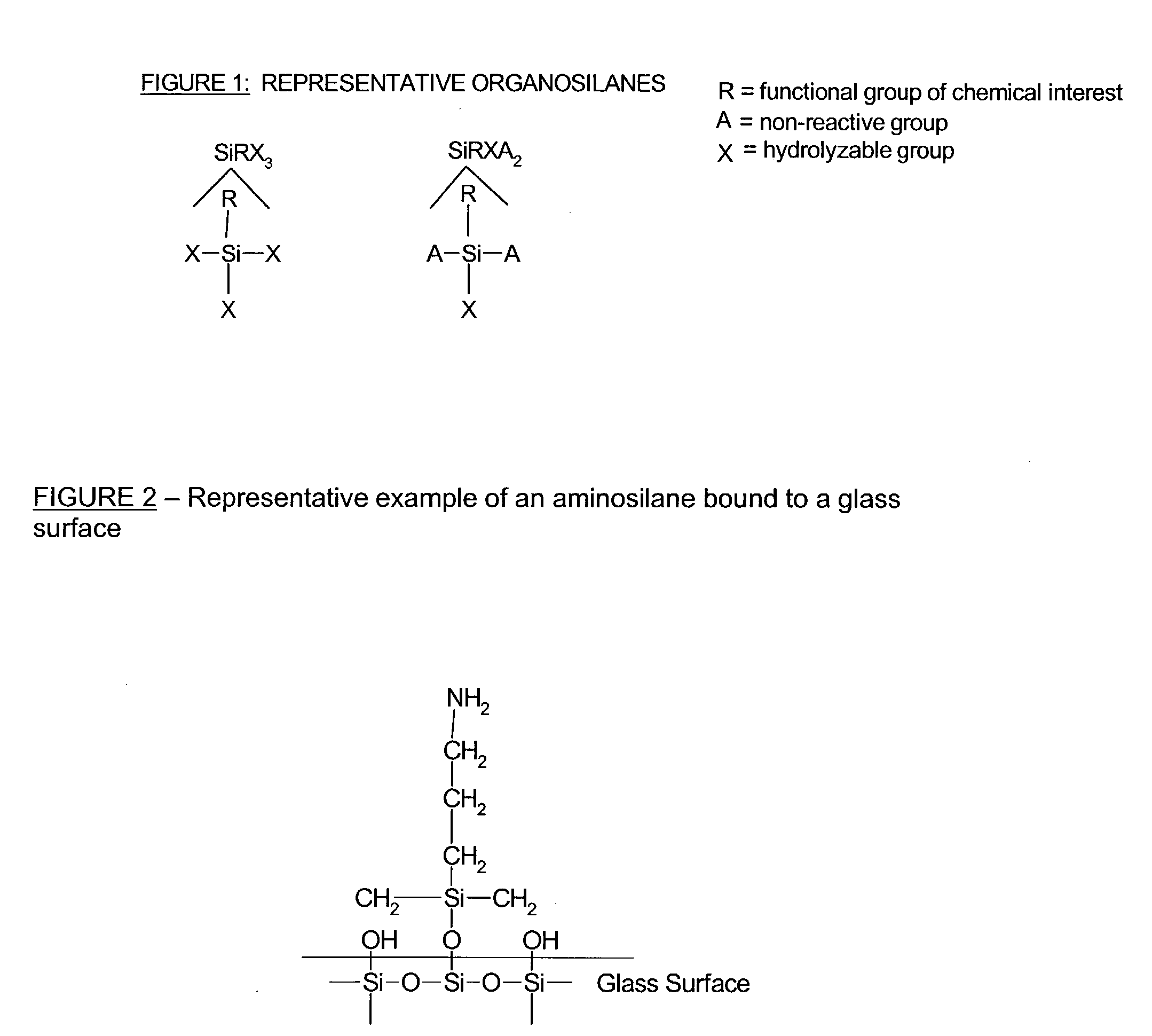Composite microarray slides
a composite microarray and microarray technology, applied in the field of composite microarray slides, can solve the problems of high variability in the volume of dna spotted in each pixel of each array, insufficient "dot-blot" procedures for applications, and the number of arrays that can be made with each dipping is usually quite small
- Summary
- Abstract
- Description
- Claims
- Application Information
AI Technical Summary
Benefits of technology
Problems solved by technology
Method used
Image
Examples
example 1
[0108] Method for the Attachment of Nylon Membrane to a Glass Substrate: Bisphenol A
[0109] Production of Nylon / Glass Composite slides useful as a composite microarray slides for carrying a microarray of biological polymers was carried out as follows.
[0110] This representative Example describes the process for producing a sample batch of the nylon / glass composite slides. The representative nylon / glass composite slides which were produced were comprised of a thin (.about.2 mil) layer of porous nylon membrane operatively bound to the surface of a three-inch (3") by one-inch (1") glass microscope slide. Such slides have proven operable as composite microarray slides useful for carrying a microarray of biological polymers.
[0111] The representative process was initiated by dissolving one packet of NoChromix (Godax Labs, Inc) into about 2.5L of concentrated sulfuric acid, then stirring thoroughly until all crystals were dissolved to produce a cleaning solution. Next, the previously prepare...
example 2
[0133] Method for the Attachment of Nylon Membrane to a Glass Substrate: Bisphenol A / Epikure 3125
[0134] Production of Nylon / Glass Composite slides useful as a composite microarray slides for carrying a microarray of biological polymers was carried out in the same manner as Example 1, with the following exceptions:
[0135] Formulation of a representative epoxy solution was as follows:
[0136] about 10 grams Epon 828 (a Bisphenol A type epoxy resin); and
[0137] about 35 grams Xylene.
[0138] In a second 250 mL Erlenmeyer flask, the following were also added:
[0139] about 6 grams Epikure 3125 (a polyamide based curing agent);
[0140] about 35 grams Xylene; and
[0141] about 1.8 grams 3-glycidopropyltrimethoxysilane.
[0142] The representative Epoxy solution was poured into the second flask, and the solution mixed for about five (5) hrs at about 60.degree. C. The solution was then mixed and applied to slides in a similar manner as Example 1. One notable difference from the representative solution of ...
example 3
[0144] Method for the Attachment of Nylon Membrane to a Glass Substrate: Adcote 89R3 (Obtained from Rohm and Haas)
[0145] This representative Example describes another representative process for producing a sample batch of nylon / glass composite slides. The nylon / glass composite slides which were produced were comprised of a thin (.about.4 mil) layer of porous nylon membrane operatively bound to the surface of a three-inch (3") by one-inch (1") glass microscope slide. Such slides have proven operable as a composite microarray slides useful for carrying a microarray of biological polymers.
[0146] Production of Nylon / Glass Composite slides useful as a composite microarray slides for carrying a microarray of biological polymers was carried out as follows:
[0147] The representative process was initiated by dissolving one packet of NoChromix (Godax Labs, Inc) into about 2.5L of concentrated sulfuric acid, then stirring thoroughly until all crystals were dissolved. Next, the resulting solutio...
PUM
| Property | Measurement | Unit |
|---|---|---|
| Time | aaaaa | aaaaa |
| Time | aaaaa | aaaaa |
| Time | aaaaa | aaaaa |
Abstract
Description
Claims
Application Information
 Login to View More
Login to View More - R&D
- Intellectual Property
- Life Sciences
- Materials
- Tech Scout
- Unparalleled Data Quality
- Higher Quality Content
- 60% Fewer Hallucinations
Browse by: Latest US Patents, China's latest patents, Technical Efficacy Thesaurus, Application Domain, Technology Topic, Popular Technical Reports.
© 2025 PatSnap. All rights reserved.Legal|Privacy policy|Modern Slavery Act Transparency Statement|Sitemap|About US| Contact US: help@patsnap.com



